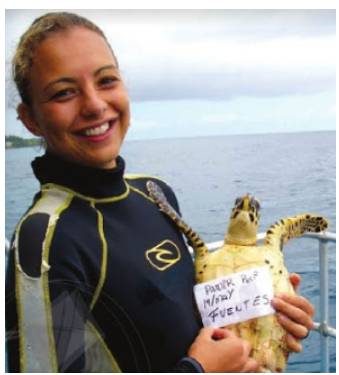Sylvia Earle, underwater hero She has spent her working life studying the world's oceans Sylvia Earle is an underwater explorer and marine biologist who was born in the USA in 1935. She became interested in the world's oceans from an early age. As a child, she liked to stand on the beach for hours and look at the sea, wondering what it must be like under the surface.
When she was 16, she finally got a chance to make her first dive. It was this dive that inspired her to become an underwater explorer. Since then, she has spent more than 6,500 hours under water, and has led more than seventy expeditions worldwide. She has also made the deepest dive ever, reaching a record-breaking depth of 381 metres.
In 1970, she became famous around the world when she became the captain of the first all-female team to live under water. The team spent two weeks in an underwater 'house'. The research they carried out showed the damage that pollution was causing to marine life, and especially to coral reefs. Her team also studied the problem of over-fishing. Fishing methods meant that people were catching too many fish, Earle warned, and many species were in danger of becoming extinct.
Since then she has written several books and magazine articles in which she suggests ways of reducing the damage that is being done to the world's oceans. One way, she believes, is to rely on fish farms for seafood, and reduce the amount of fishing that is done out at sea. Although she no longer eats seafood herself, she realises the importance it plays in our diets. It would be wrong to tell people they should stop eating fish from the sea, she says. However, they need to reduce the impact they are having on the ocean's supplies.
Choose NO MORE THAN TWO WORDS AND/OR A NUMBER FROM THE PASSAGE for each answer.
1. What career did Sylvia decide to follow after her first dive? ……………………………………………………………………….
2. How far under water did she go in order to break a world record? ……………………………………………………………………….
3. What was causing harm to everything living in the sea? ……………………………………………………………………….
4. Where does Sylvia think we should get our fish from? ……………………………………………………………………….
Decide if these statements are TRUE, FALSE or NOT GIVEN according to the information in the passage.
1. …… Sylvia Earle lives in the USA.
2. …… At the age of 18, she hadn’t made any dive.
3. …… The experience of a close death by drowning caused her to become an underwater explorer.
4. …… Nobody in the world has dived a further depth than Sylvia Earle.
5. …… The team made a fortnight stay in a laboratory to studied the underwater house.
6. …… Until 1970, nobody had lived underwater before.
7. …… Sylvia Earle was worried about the amount of fish that were being caught.
8. …… Although people were catching too many fishes, marine life suffered from no extinct dangers as the ocean were huge with a great many kinds of fishes.
9. …… Her books offer some solutions to marine problems.
10. …… She thinks people should avoid eating seafood



Hướng dẫn dịch
Rhian Waller là một nhà thám hiểm địa lý quốc gia. Cô giảng dạy tại trung tâm Darling Marine ở Hoa Kỳ. Cô ấy nghiên cứu động vật sống ở những nơi khắc nghiệt. Cô rất quan tâm đến san hô và thường xuyên lặn trong nước lạnh để nghiên cứu chúng.